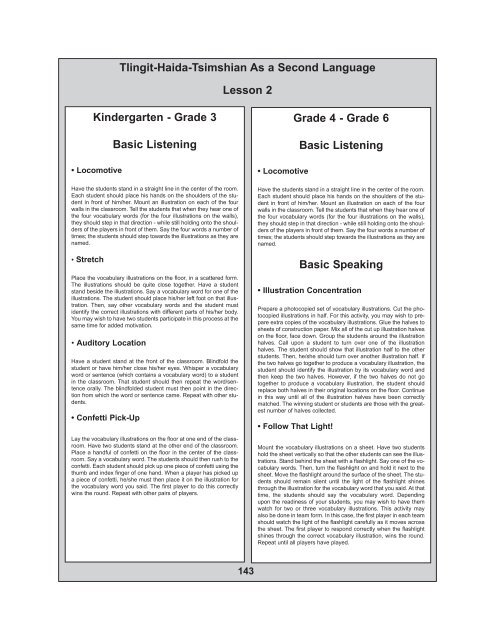Download - Sealaska Heritage Institute
Download - Sealaska Heritage Institute
Download - Sealaska Heritage Institute
You also want an ePaper? Increase the reach of your titles
YUMPU automatically turns print PDFs into web optimized ePapers that Google loves.
Tlingit-Haida-Tsimshian As a Second Language<br />
Lesson 2<br />
Kindergarten - Grade 3<br />
• Locomotive<br />
Basic Listening<br />
Have the students stand in a straight line in the center of the room.<br />
Each student should place his hands on the shoulders of the student<br />
in front of him/her. Mount an illustration on each of the four<br />
walls in the classroom. Tell the students that when they hear one of<br />
the four vocabulary words (for the four illustrations on the walls),<br />
they should step in that direction - while still holding onto the shoulders<br />
of the players in front of them. Say the four words a number of<br />
times; the students should step towards the illustrations as they are<br />
named.<br />
• Stretch<br />
Place the vocabulary illustrations on the floor, in a scattered form.<br />
The il lustrations should be quite close together. Have a stu dent<br />
stand beside the illustrations. Say a vocabulary word for one of the<br />
illustrations. The student should place his/her left foot on that illus -<br />
tration. Then, say other vocabulary words and the student must<br />
identify the correct illustrations with different parts of his/her body.<br />
You may wish to have two students partici pate in this pro cess at the<br />
same time for added motivation.<br />
• Auditory Location<br />
Have a student stand at the front of the classroom. Blindfold the<br />
student or have him/her close his/her eyes. Whisper a vocabulary<br />
word or sentence (which contains a vocabulary word) to a student<br />
in the classroom. That student should then repeat the word/sentence<br />
orally. The blindfolded student must then point in the direction<br />
from which the word or sentence came. Repeat with other students.<br />
• Confetti Pick-Up<br />
Lay the vocabulary illustrations on the floor at one end of the classroom.<br />
Have two students stand at the other end of the classroom.<br />
Place a handful of confetti on the floor in the center of the classroom.<br />
Say a vocabulary word. The students should then rush to the<br />
confetti. Each student should pick up one piece of confetti using the<br />
thumb and index finger of one hand. When a player has picked up<br />
a piece of confetti, he/she must then place it on the illustration for<br />
the vocabulary word you said. The first player to do this correctly<br />
wins the round. Repeat with other pairs of players.<br />
• Locomotive<br />
Grade 4 - Grade 6<br />
Basic Listening<br />
Have the students stand in a straight line in the center of the room.<br />
Each student should place his hands on the shoulders of the student<br />
in front of him/her. Mount an illustration on each of the four<br />
walls in the classroom. Tell the students that when they hear one of<br />
the four vocabulary words (for the four illustrations on the walls),<br />
they should step in that direction - while still holding onto the shoulders<br />
of the players in front of them. Say the four words a number of<br />
times; the students should step towards the illustrations as they are<br />
named.<br />
Basic Speaking<br />
• Illustration Concentration<br />
Prepare a photocopied set of vocabulary illustrations. Cut the photocopied<br />
illustrations in half. For this activity, you may wish to prepare<br />
extra copies of the vocabulary illustrations. Glue the halves to<br />
sheets of construction paper. Mix all of the cut up illus tration halves<br />
on the floor, face down. Group the students around the illus tration<br />
halves. Call upon a student to turn over one of the illus tration<br />
halves. The student should show that illustration half to the other<br />
students. Then, he/she should turn over another illus tration half. If<br />
the two halves go together to produce a vocabulary illustration, the<br />
student should identify the illustra tion by its vo cabulary word and<br />
then keep the two halves. However, if the two halves do not go<br />
together to produce a vocab ulary illustration, the stu dent should<br />
replace both halves in their original locations on the floor. Con tinue<br />
in this way until all of the illustration halves have been correctly<br />
matched. The winning stu dent or students are those with the greatest<br />
num ber of halves collected.<br />
• Follow That Light!<br />
Mount the vocabulary illustrations on a sheet. Have two students<br />
hold the sheet vertically so that the other students can see the illus -<br />
trations. Stand be hind the sheet with a flashlight. Say one of the vo -<br />
cabulary words. Then, turn the flashlight on and hold it next to the<br />
sheet. Move the flashlight around the surface of the sheet. The stu -<br />
dents should re main silent until the light of the flashlight shines<br />
through the illustra tion for the vocabulary word that you said. At that<br />
time, the students should say the vocabulary word. Depending<br />
upon the readiness of your students, you may wish to have them<br />
watch for two or three vocabulary illustrations. This activity may<br />
also be done in team form. In this case, the first player in each team<br />
should watch the light of the flashlight care fully as it moves across<br />
the sheet. The first player to respond cor rectly when the flashlight<br />
shines through the correct vocabulary illustra tion, wins the round.<br />
Repeat until all players have played.<br />
143
















